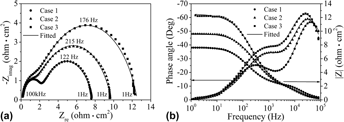Crossref Citations
This article has been cited by the following publications. This list is generated based on data provided by
Crossref.
Xie, Liuqun
Lei, Qian
Wang, Mingpu
Sheng, Xiaofei
and
Li, Zhou
2017.
Effects of aging mechanisms on the exfoliation corrosion behavior of a spray deposited Al–Zn–Mg–Cu–Zr aluminum alloy.
Journal of Materials Research,
Vol. 32,
Issue. 6,
p.
1105.
Lin, Y. C.
Jiang, Yu‐Qiang
Zhang, Jin‐Long
and
Chen, Xiao‐Min
2018.
Influence of Stress‐Aging Processing on Precipitates and Mechanical Properties of a 7075 Aluminum Alloy.
Advanced Engineering Materials,
Vol. 20,
Issue. 1,
Lin, Y.C.
Peng, Xiao-Bin
Jiang, Yu-Qiang
and
Shuai, Ci-Jun
2018.
Effects of creep-aging parameters on aging precipitates of a two-stage creep-aged Al–Zn–Mg–Cu alloy under the extra compressive stress.
Journal of Alloys and Compounds,
Vol. 743,
Issue. ,
p.
448.
Shao, Lianlian
Li, Hongtao
Jiang, Bailing
Liu, Cancan
Gu, Xin
and
Chen, Dichun
2018.
A Comparative Study of Corrosion Behavior of Hard Anodized and Micro-Arc Oxidation Coatings on 7050 Aluminum Alloy.
Metals,
Vol. 8,
Issue. 3,
p.
165.
Lin, Y C
Jiang, Yu-Qiang
Liu, Guan
and
Qin, Shengfeng
2018.
Modeling the two-stage creep-aging behaviors of an Al-Cu-Mg alloy.
Materials Research Express,
Vol. 5,
Issue. 9,
p.
096514.
Paulisch, M.C.
Treff, A.
Driehorst, I.
and
Reimers, W.
2018.
The influence of natural aging and repeated solution annealing on microstructure and mechanical properties of hot extruded alloys Al 7020 and Al 7175.
Materials Science and Engineering: A,
Vol. 709,
Issue. ,
p.
203.
Azarniya, Abolfazl
Taheri, Ali Karimi
and
Taheri, Kourosh Karimi
2019.
Recent advances in ageing of 7xxx series aluminum alloys: A physical metallurgy perspective.
Journal of Alloys and Compounds,
Vol. 781,
Issue. ,
p.
945.
Zuñiga Tello, Ishvari F.
Domínguez Almaraz, Gonzalo M.
López Garza, Víctor
and
Guzmán Tapia, Manuel
2019.
Numerical investigation of the stress concentration on 7075-T651 aluminum alloy with one or two hemispherical pits under uniaxial or biaxial loading.
Advances in Engineering Software,
Vol. 131,
Issue. ,
p.
23.
Wen, DongXu
Long, Ping
Li, JianJun
Huang, Liang
and
Zheng, ZhiZhen
2020.
Effects of linear heat input on microstructure and corrosion behavior of an austenitic stainless steel processed by wire arc additive manufacturing.
Vacuum,
Vol. 173,
Issue. ,
p.
109131.
Soleimani, Maryam
Mirzadeh, Hamed
and
Dehghanian, Changiz
2020.
Effect of grain size on the corrosion resistance of low carbon steel.
Materials Research Express,
Vol. 7,
Issue. 1,
p.
016522.
Soleimani, Maryam
Mirzadeh, Hamed
and
Dehghanian, Changiz
2020.
Effects of tempering on the mechanical and corrosion properties of dual phase steel.
Materials Today Communications,
Vol. 22,
Issue. ,
p.
100745.
Zhu, Xu-Hao
Lin, Y.C.
Wu, Qiao
and
Jiang, Yu-Qiang
2020.
Effects of aging on precipitation behavior and mechanical properties of a tensile deformed Al–Cu alloy.
Journal of Alloys and Compounds,
Vol. 843,
Issue. ,
p.
155975.
Lin, Y.C.
Wu, Qiao
He, Dao-Guang
Zhu, Xu-Hao
Liu, Dan-yang
and
Li, Xin-He
2020.
Effects of solution time and cooling rate on microstructures and mechanical properties of 2219 Al alloy for a larger spun thin-wall ellipsoidal head.
Journal of Materials Research and Technology,
Vol. 9,
Issue. 3,
p.
3566.
Soleimani, Maryam
Mirzadeh, Hamed
and
Dehghanian, Changiz
2021.
Effects of spheroidization heat treatment and intercritical annealing on mechanical properties and corrosion resistance of medium carbon dual phase steel.
Materials Chemistry and Physics,
Vol. 257,
Issue. ,
p.
123721.
Ni, Ya
and
Wu, Guoguang
2021.
Enhanced corrosion resistance of Zn–Cu–Ti alloy with addition of Cu–Ti amorphous ribbons in 3.5% NaCl solution.
Materials and Corrosion,
Vol. 72,
Issue. 7,
p.
1249.
Tian, Qing
Yang, Qiu-Mei
Lin, Yong-Cheng
Wang, Jun-Quan
and
Zhu, Xu-Hao
2021.
Effects of Aging Treatment on Corrosion Behavior of a Tensile Deformed Al-Cu-Mn-Fe-Zr Alloy in 3.5% NaCl Solution.
Materials,
Vol. 14,
Issue. 17,
p.
5062.
Wang, Xin
Du, Yuzhou
Liu, Chen
Hu, Zhitao
Li, Pengchun
Gao, Zhijie
Guo, Hui
and
Jiang, Bailing
2022.
Relationship among process parameters, microstructure, and mechanical properties of austempered ductile iron (ADI).
Materials Science and Engineering: A,
Vol. 857,
Issue. ,
p.
144063.
Shi, Liang
Huo, Da
Lei, Yanhua
Qu, Shaopeng
Chang, Xueting
and
Yin, Yansheng
2022.
Effect of microstructure on tribocorrosion of FH36 low-temperature steels.
High Temperature Materials and Processes,
Vol. 41,
Issue. 1,
p.
328.
Zhang, D.
Jiang, H.C.
Cui, Z.J.
Yan, D.S.
Song, Y.Y.
and
Rong, L.J.
2022.
Synchronous improvement of mechanical properties and stress corrosion resistance by stress-aging coupled with natural aging pre-treatment in an Al-Zn-Mg alloy with high recrystallization fraction.
Journal of Materials Science & Technology,
Vol. 121,
Issue. ,
p.
40.
Li, Guisheng
Pan, Xinyuan
Jiang, Jin
Li, Jinghui
Xie, Lingling
Liu, Haitao
and
Zhang, Mingya
2023.
Achieving ultra-fine grains and high corrosion resistance of Al–Zn–Mg–Cu alloy by ECAP and post cold rolling.
Journal of Materials Research and Technology,
Vol. 26,
Issue. ,
p.
7354.




